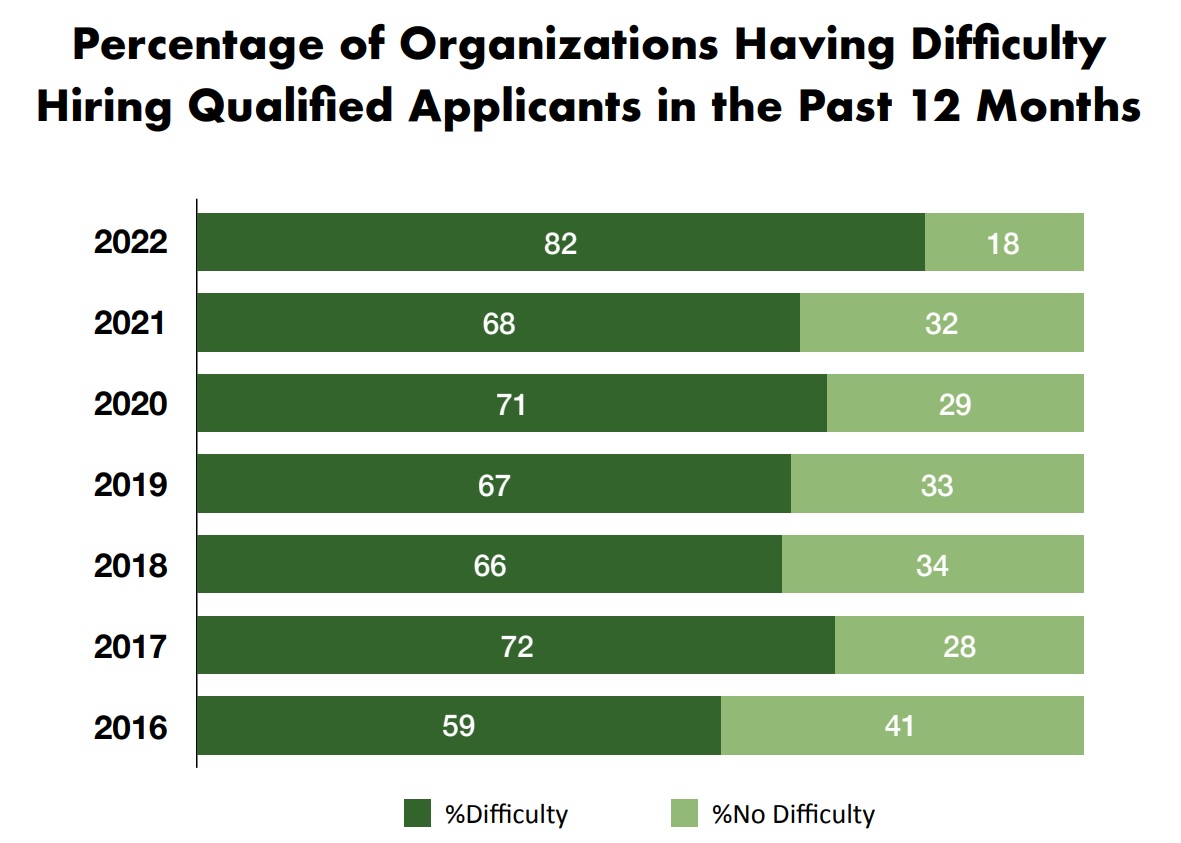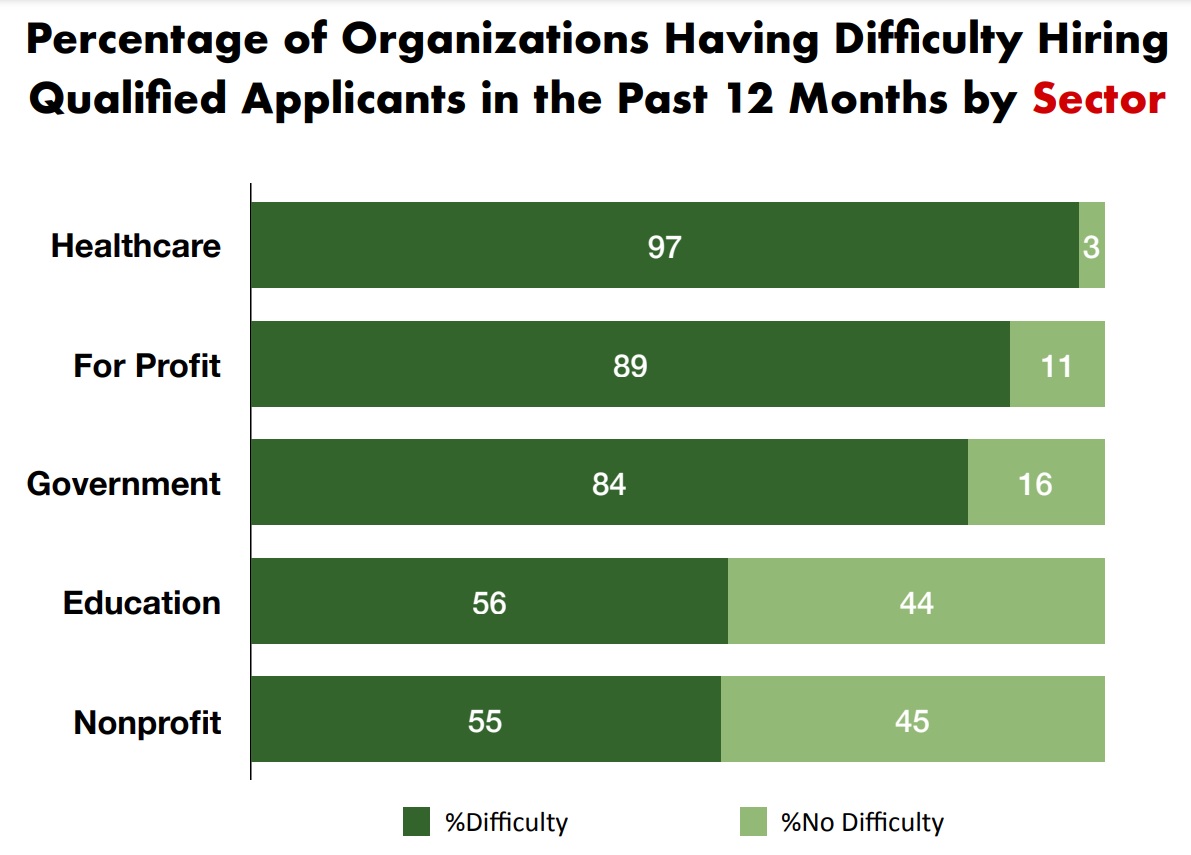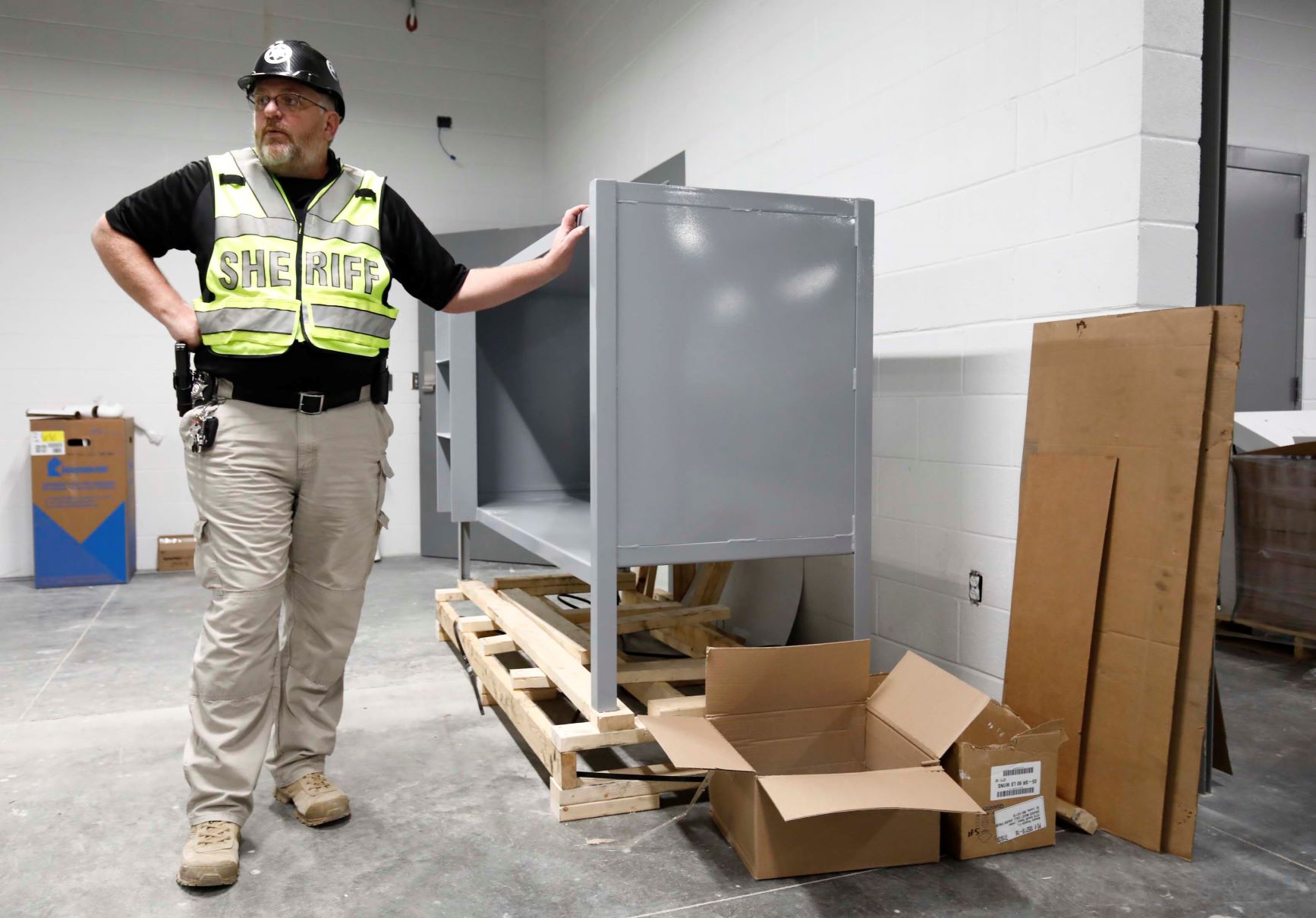“Help wanted” and “Now hiring” signs are prevalent in Springfield. Hiring managers no longer have flooded inboxes and interviews stacked on top of each other. They have trouble finding applicants — and they have expectations from employees that are unfamiliar.
Employers' dissatisfaction with finding qualified applicants has reached an all-time high, according to a recent annual survey. A whopping 90 percent of Greene County respondents reported difficulty hiring qualified applicants in 2021.
This year, 2022, marks the seventh year of the Momentum State of the Workforce survey. Employers from seven counties answered a series of questions on hiring practices, business growth, plans for the rest of the year and the challenges they face.
Summary
The Momentum survey is a yearly effort to get feedback from business owners and managers in seven southwest Missouri counties that make up Springfield and the surrounding metro area. The survey is used as a tool to determine how local governments and business organizations can better connect employers with employees and businesses with opportunities to grow.
This time in the Momentum survey, 62.7 percent of the respondents were in Greene County. Most of the questions are posed in the same way that they were in previous years, as the Springfield Department of Workforce Development looks to build baseline data that will serve as reference points over time.
The biggest problem? People aren't applying. “Lack of qualified applicants” is the No. 1 difficulty that employers reported, with a rate of 80 percent. Applicants failing to show up for job interviews was the No. 2 difficulty, with 64 percent. Employers have started calling this “ghosting.”
Employers also pointed to applications lacking relevant work experience and “Applicants unwilling to accept offered wages,” as reasons why they have difficulty hiring people to fill job openings.
Steven Bradley has lived in Springfield for about three years. He has a job, and is looking to pick up a second job in order to better his financial situation.
“This is a case of me looking for additional part-time work to make up for the fact that local cost of living and rent is going up, and a lot of our wages are not, so I'm trying to seek additional work to help with that,” Bradley said.
A key point of frustration for Bradley has been the cases where the process of applying for the job feels more involved than the job itself.
“Maybe it's just the job market evolving from what I'm used to looking for in the last 10 years or so since I've joined the workforce, but it feels like for more base-level positions, there is more required both on a resume and during the interview process,” Bradley said.
He gave an example where a minimum wage job offering 16 hours of work per week had a three-stage interview process, and that was after a fairly in-depth resume made it through the initial screening. He would have needed to attend three different interviews in order to advance into hiring negotiations — to be paid $11.15 per hour.
Increased wages not enough
Fifty-one percent of the employers in the survey reported that they tried to increase wages in response to hiring difficulties. The report states that 56 percent of the companies surveyed responded to hiring difficulties by paying overtime to skilled workers already in their company, upping their wages while also upping the demand placed on the workers.
Almost half of the respondents, 49 percent, balked and opted not to hire anyone for open positions because of difficulty they encountered trying to fill the roles.
At a 48-percent rate on the survey, employee retention and employee work ethics and habits were also among high-level concerns for employers. About half of the respondents reported that they were concerned with retaining employees once they were hired. On a separate question, about half of the employers were concerned with how attentive to the job their employees were on any given day.
The Springfield Department of Workforce Development is a city government office housed within the Missouri Job Center on East Sunshine Street. Its main mission is to connect job seekers with good places to work, and to help bridge any gaps between job seekers and employment.
Springfield Director of Workforce Development Sally Payne said that prior to the pandemic, employers had a hard time finding qualified job applicants. Today, they have a hard time finding any applicants, let alone applicants who can check all of the desired boxes on a job description.
“We really have been working with employers to look at their applicant tracking systems,” Payne said. “Pre-COVID, an employer would get hundreds of applications for one position, and it was just too much, and so they really started narrowly defining the qualifications, how they would accept and what they would screen out and what they would screen in.”
Unemployment rate does not reflect entire economy
The Missouri Department of Labor and Industrial Relations reports a statewide unemployment rate of 3.6 percent at the end of March 2022. Greene County’s unemployment rate is lower than that.
“Greene County continues to be one of the lowest unemployment rates statewide,” Payne said. “The last number was around 3 percent. I find unemployment numbers really interesting. You know, our allocations from the federal government, our money, is tied to the unemployment rate. So normally, when the economy looks good and the unemployment rate is low, the federal government tends to cut our funding.”
While unemployment rates make headlines, lead newscasts and get injected into political arguments, they don’t offer a complete picture of what job seekers, employers and workers are dealing with. Certain types of workers, particularly enterprising workers attempting to make it as contractors, freelancers or irregular workers, go without being counted.
“This is clearly what I believe is a number on paper, and I don’t know if it’s genuinely reflecting what’s going on in the economy, because we do have a lot of remote workers, gig workers, in this area, and those numbers don’t get reported into the [U.S. National] Labor Exchange at all,” Payne said.

Some of the data from the Missouri Department of Labor and Industrial Relations doesn’t reflect the true situation and the hardships that people are facing to cover all of their expenses in Springfield. People who gain much of their income from driving for services like Uber or Lyft, for instance, aren’t counted in employment or unemployment rates. Self-employed contractors who take payments out of the contracts that they complete can also go unrepresented in labor statistics.
Discouraged workers, or workers who give up on job searches, fall out of being counted in the unemployment rate.
“It’s not reflective of gig workers, and it’s not reflective of any kind of cash, but what is really hard to gauge right now is how many people are not technically participating in the labor force right now,” Payne said.
The Department of Workforce Development works to find people who are disengaged in the workforce and pair them with opportunities to find work, and the fulfillment that can come with it.
Women, for example, are not participating in the labor force at the rate they were prior to the arrival of COVID-19 in Missouri in March 2020. That's largely because women have taken over responsibilities of child care when COVID-19 eliminated more institutional options, and many did not return to the workforce. The adult women’s employment rate is at its lowest pre-pandemic level since September 1988, according to the U.S. Bureau of Labor Statistics.
“Part of the conversation lately has been working mothers, and why women have not come back to work,” Payne said. “Well, we're still remote learning off and on, but we really need to do something to engage women and get them back to work.”
They're calling it a “she-cession.” The decline in women seeking work could meaningfully contribute to the lack of applicants in the current era.
Employers consider previously hidden, underrepresented workers
The Momentum Survey asked employers if they made specific efforts to hire employees from certain underrepresented populations. It found that 61 percent of the respondents make extra efforts to hire military veterans. Fifty-five percent of the companies in the survey reported that they made special efforts to hire racial minorities.
Individuals with disabilities, stay-at-home parents and formerly incarcerated persons were less likely to benefit from special efforts on the part of recruiters or hiring managers.
Just 20 percent of the companies in the survey reported that they made special considerations to hire persons who had been in jail or in prison, while 64 percent reported that they did not take any measures to hire formerly incarcerated persons. Due to certain laws and industry regulations, not all employers are able to employ persons with criminal records, but Payne said effort is underway to work with that population in southwest Missouri.
“We will be working with those incarcerated but released back to our seven-county region, and we really have an opportunity to get those individuals back to work,” Payne said. “It's great for public safety, and it has a good economic impact, because if more people are working, the better off it is for the overall economy.”
What do employers do now?
The survey examined what strategies employers were using to try to retain employees. The most popular option, at 70 percent, was increased wages and bonuses, though the amount of money in the pay raise relative to the employees' existing wages was not specified.
Other strategies included more flexible work schedules, more training and employee recognition. Forty percent of employers said they offered career growth opportunities, which was actually down from 51 percent in 2020 and 55 percent in 2017. Only 34 percent of the employers offered remote working options, and 21 percent offered tuition reimbursement programs.
“I think about 68 percent of job applicants are really looking at the culture of an organization,” Payne said. “More demand gets put on that employer. They've had to increase wages, but now additionally, you have to look at employee culture.”
Steven Bradley, who is looking to pick up a second job, uses internet sources like Indeed.com and Facebook to search for job listings, and says that whenever possible, he looks for a direct route to speak with a business owner or a hiring manager.
Having one job, and a schedule that goes with it, has added a layer of complication to Bradley's job search. He looks at wages, incentives, community distances and scheduling when considering whether or not he will apply for a job. If he might be interested, Bradley checks out the company that posted a listing. He has found cases where companies duplicate the language in job descriptions across different platforms. Sometimes, they even duplicate the description languages for two different openings.
“They are posting the bare minimum amount of required pay necessary for a job with a lot of demands, and then there's also a full-time position that pays more that has the exact same job demands. If I'm making less doing the same work, that doesn't make any sense. That's been a frustration,” Bradley said.
Feeling valued at work is important to employees, sometimes more than salary. Payne said job seekers are more apt to examine work climates and corporate culture than they used to be. They look for flexibility, opportunities to volunteer and give back to their communities, employee assistance programs and how diverse the employees of a potential employer are.
“You see this particularly with Millenials and the Gen-Z'ers,” Payne said. “They want to be happy, they want to be valued. They want that work-life balance.”
Job searches rooted in corporate culture and opportunities outside the office can be difficult for smaller businesses, where an owner/manager may only want to hire one or two people.
“It’s harder for small employers,” Payne said. “They’ve done their best, now we’re asking even more of them.”
Panel discussion offers insight; COVID accelerated trends
Cindy Stephens, director of innovative career and technical education programs at Ozarks Technical Community College, served as the panel moderator for a discussion of the Momentum Workforce Survey results in March 2022.
“Many of you have experienced that extreme acceleration in change in the workplace; things that were on our 10-year plan were implemented during COVID,” Stephens said. “Add that, that fast-changing environment to issues of the supply chain, labor shortages and everyone is starting to rethink how they can be a little more creative in the world.”
John Sargent, human resources manager of Ozarks Coca-Cola/Dr. Pepper Bottling Company, said he felt like the pandemic served as an accelerant for some workforce shifts that were starting before 2020.
“It's crazy to think about how difficult it is to remember what it was like prior to 2020,” Sargent said. “Things have changed so much, and there are so many additional pressures on labor that were not present just two years ago. It feels like we've had 10 years, if not a generational impact and shift in just two years.”

Randy Tucker manages human resources at Dairy Farmers of America, and noted that COVID-19 will impact the labor market for years if not decades to come. Dairy Farmers of America is a union facility that works with the Teamsters in southwest Missouri. It provided wage increases for most workers, and bumped up its starting wage from $17 per hour to $20 per hour.
“We've still been able to hire, but we still experience turnover,” Tucker said. “It's the work-slash-home life balance. We certainly want our scales [to be] more even, but the world, the environment that we work in is not necessarily that way.”
Everyone, Tucker said, is a consumer. Consumption creates a demand.
“When we want our product, we want our product, and then that puts pressure on us folks that make it to get it out there on the shelf for you,” Tucker said. “It's just hours that are required. We're trying to work on schedules that reduce that, but it's still a challenge.”
Search for supplemental income continues
Sometimes, Steven Bradley said it would be nice to hear back from potential employers, even if they look at his application and decide they don't want to hire him. He recounted a story from the first year he lived in Springfield, a story he laughs about now.
“I got a job in May, and I was very happy about it,” Bradley said. “And then in August, I got a phone call from a place I had applied to in March that was like, ‘Hey, we reviewed your application. Are you interested in an interview?' And I was like, ‘If I was waiting on this job, I would have starved to death.' That felt very ridiculous to me.”
He said that searching for jobs in 2022 feels more complicated than job hunting did when he was starting out.
“I used to do a lot of warehouse work, and I felt like I could show up for a simple job interview; they would ask me if I could pass a drug test and if I could lift so many pounds. ‘Yeah.' ‘Cool, we'll get the paperwork and we'll see you the moment all of your paperwork is cleared, and you're good to work,” Bradley said.
Bradley continues his search. His long term goal is to have a job where he helps people navigate difficult situations in life.
“I really want to do social work services, library service work, or government assistance services — the kind of position where I would be helping people through the system. That has always been my aspiration,” Bradley said.
Bradley said he has a year and a half of college credit, but needs time to earn a bachelor's degree if he wants some of the jobs he might be after in the long run. To go back to school, he'll need to earn and save money.
“The pandemic sort of ate into the college money fund,” Bradley said.

COVID-19 and automation bringing change
Eighty-four percent of the employers surveyed reported they had hired at least one new full-time employee in 2021. Not all of the new hires are southwest Missouri residents. As telecommuting and working from home gained acceptance in the height of the COVID-19 pandemic, several Springfield companies turned to workers who live in other parts of the United States.
“Over 50 percent said their new hires came from outside the Ozark region, so it kind of makes you think about remote work,” Payne said. “Is remote work causing employers to look outside, or is that an opportunity for an organization? If they can't get the workers here, maybe with remote work, they can get the workers from outside the region.”
“COVID just really accelerated what was happening anyway, and we do have a population decrease, and we've heard it before, we talked about it before; it's nothing that we're going to be able to birth ourselves out of,” Payne said.
The workforce in Missouri and across the United States experienced a significant number of retirements during the COVID-19 pandemic, as persons of retirement age opted to go ahead and take their retirement instead of working extra years.
“A lot of organizations are looking to automate to make up for that labor shortage,” Payne said. “A lot of workers, employees are scared of automation, they think it’s going to mean loss of jobs, but according to our survey, that won’t happen.”
Even if all employees are retained when companies turn to automating processes that people used to do, that doesn’t mean that their job duties won’t change.
“Automation will require re-training of existing workers, so there will probably be a greater emphasis on training those incumbent workers, those current employees on the automation process,” Payne said.
Looking ahead to the rest of 2022
Not all jobs can be automated. Health care is one of the top employment sectors in the Springfield metropolitan area. Springfield’s two major hospital systems are hiring for jobs across the market, and the difficulties they encounter filling jobs make it difficult for health care systems to expand.
“You can see that health care wants to expand,” Payne said. “Every sector has been affected by COVID in some way, there is no getting around that, but health care has been affected greatly. A lot of health care workers have left health care due to COVID, and I think they're affected with recruiting nurses.”
It's not just hospitals, Payne said. She also felt discouraged with the number of workers leaving nursing homes or assisted living facilities in order to find work in other areas of employment.
Payne is advocating for the use of apprenticeship programs, and not just by private sector employers who hire skilled laborers. Public sector employers can also use apprenticeships as a way to attract talent.
“For example, our city fire department just implemented a registered apprenticeship, and so it was a huge boost to their academy because (apprentices) are being paid as an employee from the very beginning,” Payne said.
The Springfield City Council has approved a bill to allow the Department of Workforce Development to apply for two grants through the Apprenticeship Building America (ABA) program authorized by the U.S. Department of Labor. If awarded, the ABA grantees will work with a range of partners to support the development of a registered apprenticeship ecosystem for public entities.
The first grant ask is for $3 million and will be used to ensure equitable pathways for individuals through pre-apprenticeships that lead to a registered apprenticeships. The second ask is for $6 million and will be used to invest in an apprenticeship hub to facilitate the establishment, scaling and expansion of equitable registered apprenticeships for public sector career paths.
“If awarded, we will use the $3 million grant to establish and develop pre-apprenticeships that lead to registered apprenticeships for public sector jobs throughout southern Missouri, ensuring everyone has access to these career paths,” Payne said.
The Springfield Department of Workforce Development should know if it wins the grants sometime in July.
“If we are awarded the $6 million grant we will create a network or hub to teach other public entities how to create or expand registered apprenticeships within their county or municipality,” Payne added.




